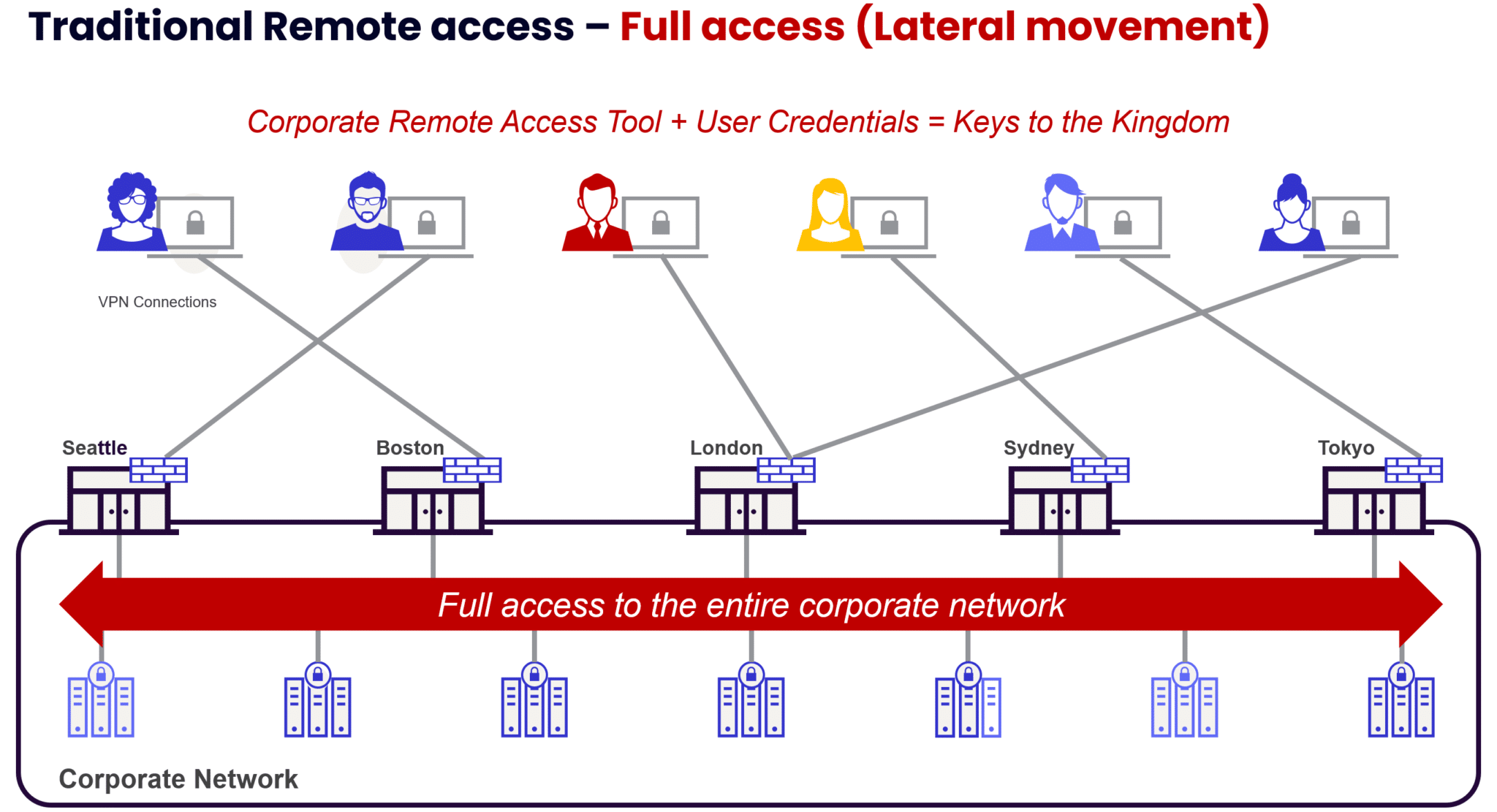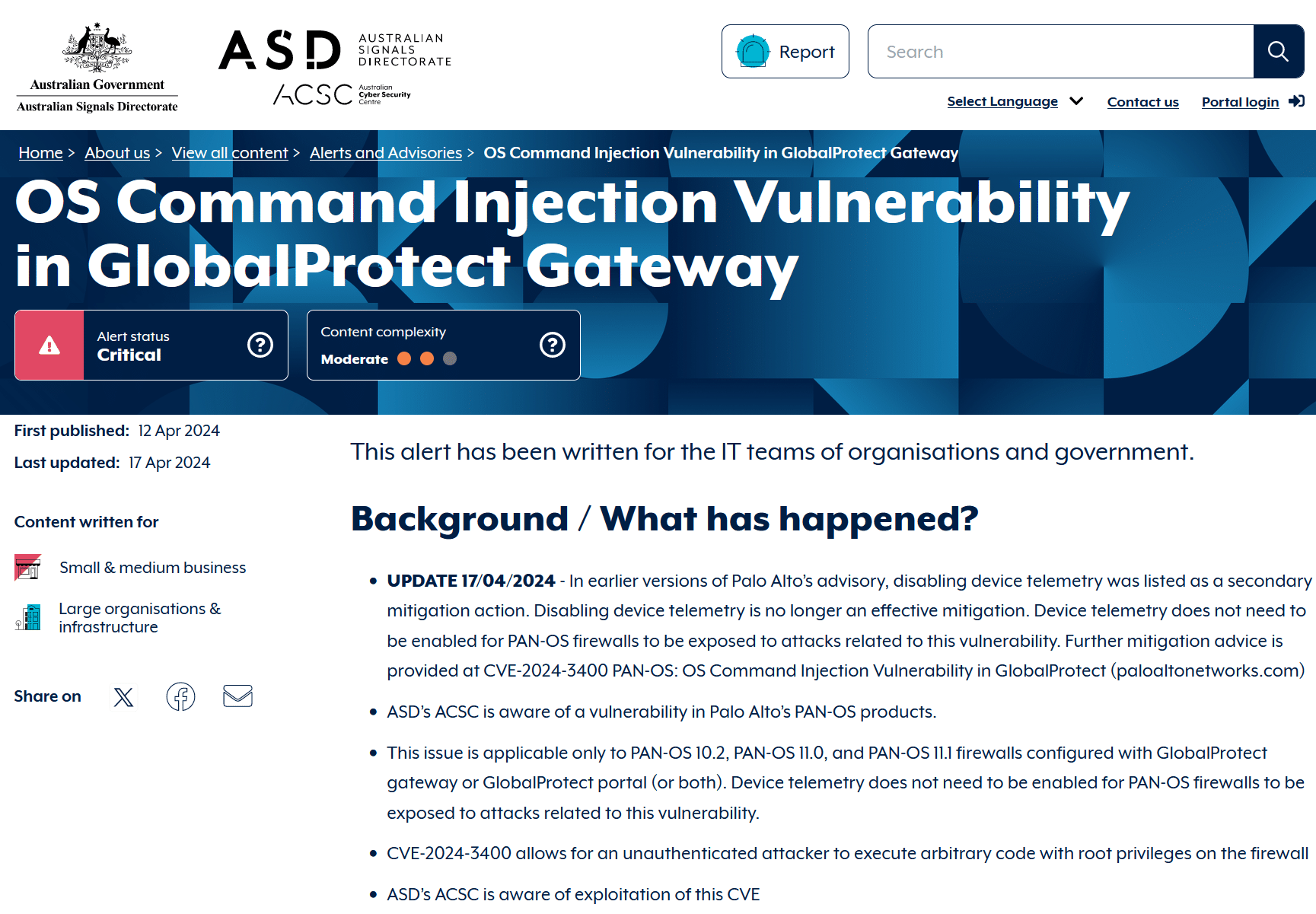The past year has been a constant game of whack-a-mole with VPN vulnerabilities, leaving organizations that use outdated remote access systems wide open to potential cyberattacks. Hackers are exploiting critical flaws in everyday software, from VPNs—like the high-severity Ivanti CVEs and the Fortinet FortiVPN events—to firewalls like Palo Alto Networks PAN-OS and messaging applications like Telegram. By allowing adversaries to take complete control of devices through remote code execution or block access to devices with Denial-of-Service (DoS) attacks, these vulnerabilities put your valuable data at risk.
In December 2023, Chinese state-backed hackers exploited zero-day vulnerabilities (CVE-2023-46805 & CVE-2023-21887) in Ivanti VPN products, enabling unauthorized access through authentication bypass and remote control through remote command injection. Even after patches were released, attackers found new vulnerabilities (CVE-2024-21888) to bypass the fixes and continue their malicious activities.
This February, the U.S. Cybersecurity and Infrastructure Security Agency (CISA) sounded the alarm about another VPN attack. This time, the target was Cisco ASA security appliances, which combine firewall, antivirus, intrusion prevention, and virtual VPN capabilities. The culprit was a known vulnerability (CVE-2020-3259) exploited by the Akira ransomware group, which attacks both Windows and Linux systems. The cybercrime organization took advantage of misconfigured WebVPN/AnyConnect setups to steal data.
This most recent vulnerability is from Palo Alto Networks. This critical zero-day, tracked as CVE-2024-3400, impacts the vendor’s its GlobalProtect VPN product. The critical security hole found in Palo Alto Networks PAN-OS allows attackers to gain full control with root privileges of the firewall itself and the VPN connectivity it facilitates, all without requiring a username and password. To put it simply, this zero-day threat has the highest severity score possible: 10 out of 10.
In the initial discovery article released by Volexity, the research found that the attacker focused on exporting configuration data from the devices and then leveraging it as an entry point to move laterally within the targeted organizations.
These repeated attacks using zero-day exploits highlight a concerning trend: the problem lies with the outdated architecture of VPNs themselves, not with any particular vendor.
 Figure 1. CISA has released an advisory confirming active exploitation initiated by leveraging the Palo Alto Networks vulnerability.
Figure 1. CISA has released an advisory confirming active exploitation initiated by leveraging the Palo Alto Networks vulnerability.
Why do these incidents occur?
Over the past several years, SSL VPN products have been targeted by a wide range of threat actors, both financially motivated cyber criminals and nation-state hacktivists. How do you explain this phenomenon? The answer is a relatively simple one: SSL VPNs can serve as an entry point for accessing a treasure trove of valuable corporate data. They provide a direct path into a company’s network, making them a valuable staging ground for further attacks.
 Figure 2. Legacy VPN architectures continue to present vast opportunities to attackers.
Figure 2. Legacy VPN architectures continue to present vast opportunities to attackers.
The surge in remote work after the COVID-19 pandemic has transformed SSL VPNs into a double-edged sword. Because they are easy to access, attackers can exploit remote workers’ susceptibility to phishing and other socially engineered attacks.
Recent VPN and firewall vulnerabilities, like the Palo Alto Networks GlobalProtect flaw, highlight another concerning trend. This isn’t about pointing the finger at specific vendors. Rather, it’s about the fundamental design flaw in these technologies. Organizations need to be aware that internet-facing assets like firewalls and VPNs are prime targets for breaches. Once attackers gain access, traditional legacy architectures allows them to move freely within the network, stealing sensitive data and compromising critical applications.
The US Cybersecurity and Infrastructure Security Agency (CISA) and the Australian Cyber Security Centre (ACSC) have published guidance recommending that organizations of all sizes—particularly those in government—act swiftly due to the severity of the vulnerability. These articles include additional resources to assist with patching and limiting exposure where possible.
 Figure 3. The Australian Cyber Security Centre (ACSC) has released advisory guidance confirming active exploitation.
Figure 3. The Australian Cyber Security Centre (ACSC) has released advisory guidance confirming active exploitation.
Patching vulnerabilities remains crucial, but for a truly proactive defense against zero-day attacks, a Zero Trust architecture offers the most significant advantage.
There are a number of fundamental steps to help limit exposure:
- Minimize attack points: Make critical applications and vulnerable VPNs invisible online to prevent initial breaches.
- Confine breaches: Connect users directly to applications to minimize damage from compromised systems.
- Stop threats at the gate: Continuously inspect all traffic to automatically block emerging threats.
- Limit access privileges: Give users only the access they need in order to prevent unauthorized actions.
“Zero Trust” has become a buzzword in the security space, but, when done right, it’s an approach that has real value. By implementing Zero Trust principles and its underlying architecture, companies can effectively address the security risks plaguing traditional networks, including serious exposures from vulnerabilities in firewall and VPN products.
If you can minimize reliance on VPN and thereby nullify the risk of being exposed again by another vulnerability, why not explore that option? Zero Trust throws out the old rulebook. Unlike traditional networks secured by firewalls and VPNs, Zero Trust does not rely on a central “trusted zone.” Instead, it creates secure connections directly between users and the specific resources they need. This goes beyond just users and applications. Zero Trust can connect workloads, branch offices, remote workers, even industrial control systems.
Skyhigh Security enables this by facilitating a secure connection to authorized applications rather than directing the requesting user or device to the corporate network. Every user, device, and connection is continuously verified before access is granted to sensitive resources. Trust is never granted by default, ensuring data safety and integrity at all times, without compromising availability or performance for your users.
 Figure 4. How a Zero Trust architecture drastically limits the attack surface, particularly with vulnerabilities, exploits, and lateral movement attacks looming.
Figure 4. How a Zero Trust architecture drastically limits the attack surface, particularly with vulnerabilities, exploits, and lateral movement attacks looming.
It’s time for security leaders to embrace Zero Trust. This cloud-based approach shrinks the attack surface by eliminating vulnerabilities associated with firewalls, VPNs, and other legacy technologies. By denying attackers their usual entry points, Zero Trust creates a stronger defense and more robust security posture.
References: